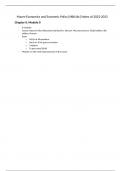Class notes
Class notes Macro economics and Economic Policy (HBA16C) Macroeconomics, Global Edition
- Course
- Institution
- Book
A class note for macroeconomics 2nd year of Bachelor of Business Administration, BBA, KU Leuven. Got 14/20, if wondering.
[Show more]



